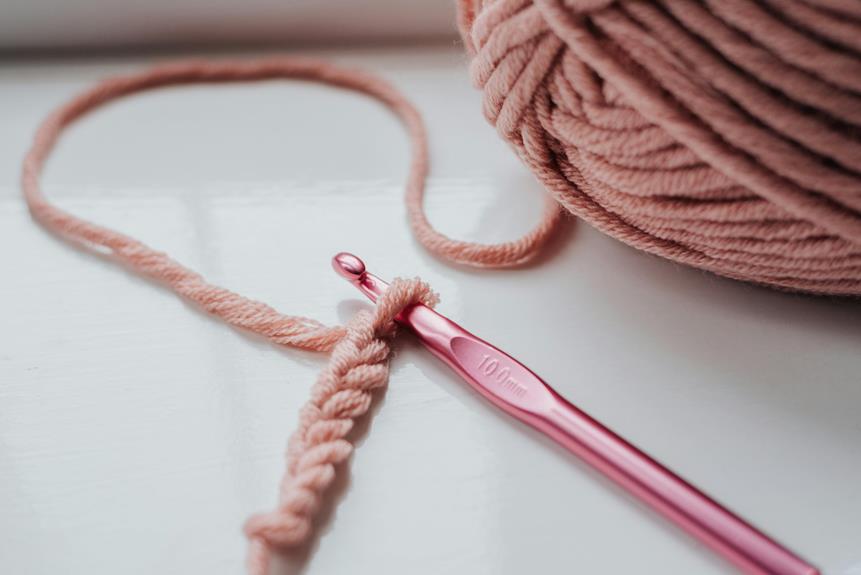If you're looking to create your own fabric wax, you're in for a practical endeavor that can enhance your textiles. You'll find that the process is straightforward, requiring just a few essential ingredients. As you combine beeswax and jojoba oil, you'll not only gain a better understanding of the materials but also discover the benefits of having a custom product on hand. However, before you jump in, consider the various applications and tips that can elevate your fabric care routine—there's more to this than meets the eye.
Table of Contents
Key Takeaways
- Combine 1 part beeswax and 1 part jojoba oil in a double boiler, melting the beeswax until fully liquefied.
- Mix in tree resin for added stickiness and durability; ensure all ingredients are pure and high-quality.
- Pour the warm mixture into a container, allowing it to cool and solidify for easy storage.
- Apply the wax in small sections using a heat source for better penetration and multiple thin layers for increased waterproofing.
Understanding Fabric Wax Benefits
Fabric wax offers you a range of benefits, from enhancing water resistance to prolonging the lifespan of your fabrics. By applying fabric wax, you create a protective barrier that repels moisture, preventing water from soaking into your materials. This is especially useful for outdoor gear, clothing, or any fabric you want to keep dry.
In addition to water resistance, fabric wax helps shield your fabrics from dirt and stains. It makes cleaning easier, as spills are less likely to penetrate the fibers. This protective layer also reduces wear and tear, meaning your favorite items will last longer, saving you money in the long run.
Another benefit is that fabric wax can enhance the appearance of your fabrics. It gives them a subtle sheen, making them look fresh and well-maintained. Plus, it can help restore the original texture of worn fabrics.
Lastly, applying fabric wax is a straightforward process that doesn't require specialized skills. With just a little time and effort, you can enjoy these benefits, making your fabrics not only more functional but also more aesthetically pleasing.
Essential Ingredients for Fabric Wax
To make your own fabric wax, you'll need a few key ingredients that work together to create a protective barrier for your materials.
The primary component is beeswax, which provides the necessary waterproofing and flexibility. When selecting beeswax, opt for high-quality, pure beeswax to ensure optimal performance.
Next, you'll want to include a natural oil, like jojoba or coconut oil. This oil helps to soften the beeswax, making it easier to apply while enhancing the fabric's breathability. The right oil will also help prevent the wax from becoming too brittle.
Another essential ingredient is tree resin, such as pine resin. This adds stickiness to the mixture, improving adhesion to the fabric and enhancing the wax's durability. When choosing resin, ensure it's clean and free from impurities.
Step-by-Step Fabric Wax Recipe
Gather your ingredients and follow these simple steps to create your own fabric wax.
Start by measuring out 1 part beeswax and 1 part jojoba oil. You can adjust the quantities depending on how much fabric wax you need, but a good starting point is 1 cup of each.
Next, set up a double boiler on your stove. Fill the bottom pot with water and bring it to a simmer. Place the beeswax in the top pot and let it melt slowly. Stir occasionally to ensure even melting. Once the beeswax is fully melted, add in the jojoba oil and mix well until fully combined.
Remove the mixture from the heat and let it cool for a few minutes. While it's still liquid, pour the wax into a container or tin that you can easily access later. Let it cool completely at room temperature until it solidifies.
Your fabric wax is now ready to use! Remember to store it in a cool, dry place to maintain its consistency. Now you've got a homemade fabric wax that's perfect for waterproofing and preserving your fabrics.
Tips for Application and Use
Applying fabric wax is simple, and you'll want to make sure your fabric is clean and dry for the best results. Start by spreading your fabric out on a flat surface, ensuring it's fully extended to avoid wrinkles. Then, using a brush or your fingers, apply a thin, even layer of the wax to the fabric.
Here are some tips to enhance your application:
- Work in small sections: It's easier to manage the wax and ensures even coverage.
- Heat it up: A heat gun or hairdryer can help melt the wax into the fabric, making it more effective.
- Test first: Try the wax on a small, inconspicuous area to see how it reacts before doing the whole piece.
After applying, let the fabric sit for a few hours to allow the wax to set. Once it's dry, your fabric will be more durable and water-resistant, perfect for whatever project you're tackling!
Storing Your Homemade Fabric Wax
After you've successfully applied the fabric wax, it's important to know how to store any leftover homemade wax to maintain its quality for future use. Proper storage ensures that your wax remains effective and ready for your next project.
Here are some key storage tips you should follow:
| Storage Method | Details |
|---|---|
| Airtight Container | Keep your fabric wax in a clean, airtight container. This prevents moisture and air from degrading it. |
| Cool, Dark Place | Store the container in a cool, dark area to prolong its shelf life. Avoid direct sunlight or heat sources. |
| Label and Date | Always label your container with the date you made the wax. This helps you keep track of freshness. |
Creative Uses for Fabric Wax
Now that you've made your fabric wax, it's time to explore its creative uses.
You can waterproof your fabric projects, create reusable food wraps, or even craft unique art pieces.
Let's look at how to get the most out of your homemade fabric wax.
Waterproofing Fabric Projects
Fabric wax transforms ordinary textiles into waterproof wonders, making it perfect for a variety of creative projects. You can use it to enhance your favorite fabrics, allowing you to explore new possibilities in your crafting. Whether you're looking to create practical items or unique gifts, fabric wax can elevate your designs by keeping them protected from moisture.
Here are some fantastic ways to use fabric wax for waterproofing:
- Outdoor gear: Coat your backpacks or tents to keep them dry during unexpected rain.
- Aprons: Make your kitchen aprons spill-resistant, so you can cook without worrying about stains.
- Bags: Create stylish, functional bags that can withstand wet weather, perfect for everyday use.
With fabric wax, you're not just waterproofing; you're also adding durability and a unique touch to your projects. So grab your homemade fabric wax and start transforming your textiles into reliable, waterproof creations that stand the test of time!
Reusable Food Wraps
Transforming your leftover fabric into reusable food wraps not only reduces waste but also adds a sustainable touch to your kitchen. With fabric wax, you can create eco-friendly alternatives to plastic wrap that keep your food fresh without harming the environment.
To make your reusable food wraps, start by cutting the fabric into various sizes—think small squares for cheese or larger rectangles for covering bowls. Next, melt your homemade fabric wax mixture and spread it evenly on one side of the fabric using a brush or your fingers. Make sure to cover the entire surface for maximum effectiveness.
Once the wax cools and hardens, your wraps are ready to use! Simply warm them in your hands to mold around food items or dishes. They're perfect for wrapping sandwiches, covering leftovers, or even storing fruits and vegetables.
After use, rinse them in cold water with mild soap, and let them air dry. With proper care, your reusable food wraps can last for up to a year, making them a practical and stylish kitchen solution.
You'll reduce plastic waste while enjoying beautifully wrapped food!
Crafting Unique Art Pieces
You can unleash your creativity by using fabric wax to craft unique art pieces that showcase your personal style. Whether you're a seasoned artist or a beginner, fabric wax can add texture and intrigue to your creations. It's versatile and allows you to experiment with different techniques and designs.
Here are some fun ways to use fabric wax in your art:
- Textile Collages: Combine various fabrics with fabric wax to create stunning layered collages. The wax adds structure and durability to your artwork.
- Stenciled Designs: Use stencils to apply fabric wax on a canvas or cloth. This technique can create intricate patterns and add depth to your pieces.
- Color Blocking: Experiment with different colors of fabric wax to create bold, eye-catching blocks of color. This modern approach can transform a simple fabric into a statement piece.
Let your imagination run wild, and enjoy the process of creating!
Frequently Asked Questions
Can I Use Fabric Wax on All Types of Fabrics?
You can use fabric wax on many fabrics, but it's best to test a small area first. Delicate materials or those with special finishes might not react well, so proceed with caution to avoid damage.
How Long Does Homemade Fabric Wax Last?
Homemade fabric wax typically lasts around six months when stored properly. Keep it in a cool, dry place, and make sure the container is sealed to maintain its effectiveness and prevent contamination.
Is It Safe for Children's Clothing?
Yes, it's generally safe for children's clothing if you use non-toxic ingredients. Always test a small area first and ensure it's fully cured before letting your child wear the item to avoid any potential irritation.
Can I Add Essential Oils for Fragrance?
Yes, you can add essential oils for fragrance! Just be mindful of the oil's potency, as a little goes a long way. Test it on a small fabric piece to ensure you like the scent.
What's the Best Way to Remove Fabric Wax?
To remove fabric wax, you can place a paper towel over the wax and use a warm iron. The heat'll melt the wax, allowing it to absorb into the towel, leaving your fabric clean.
- Can You Dye Polycotton? A Step-by-Step Guide for Best Results - June 23, 2025
- Are Polycotton Tents Waterproof? Everything Campers Need to Know - June 23, 2025
- Are Polycotton Sheets Good? A Buyer’s Guide to Durability and Comfort - June 23, 2025







